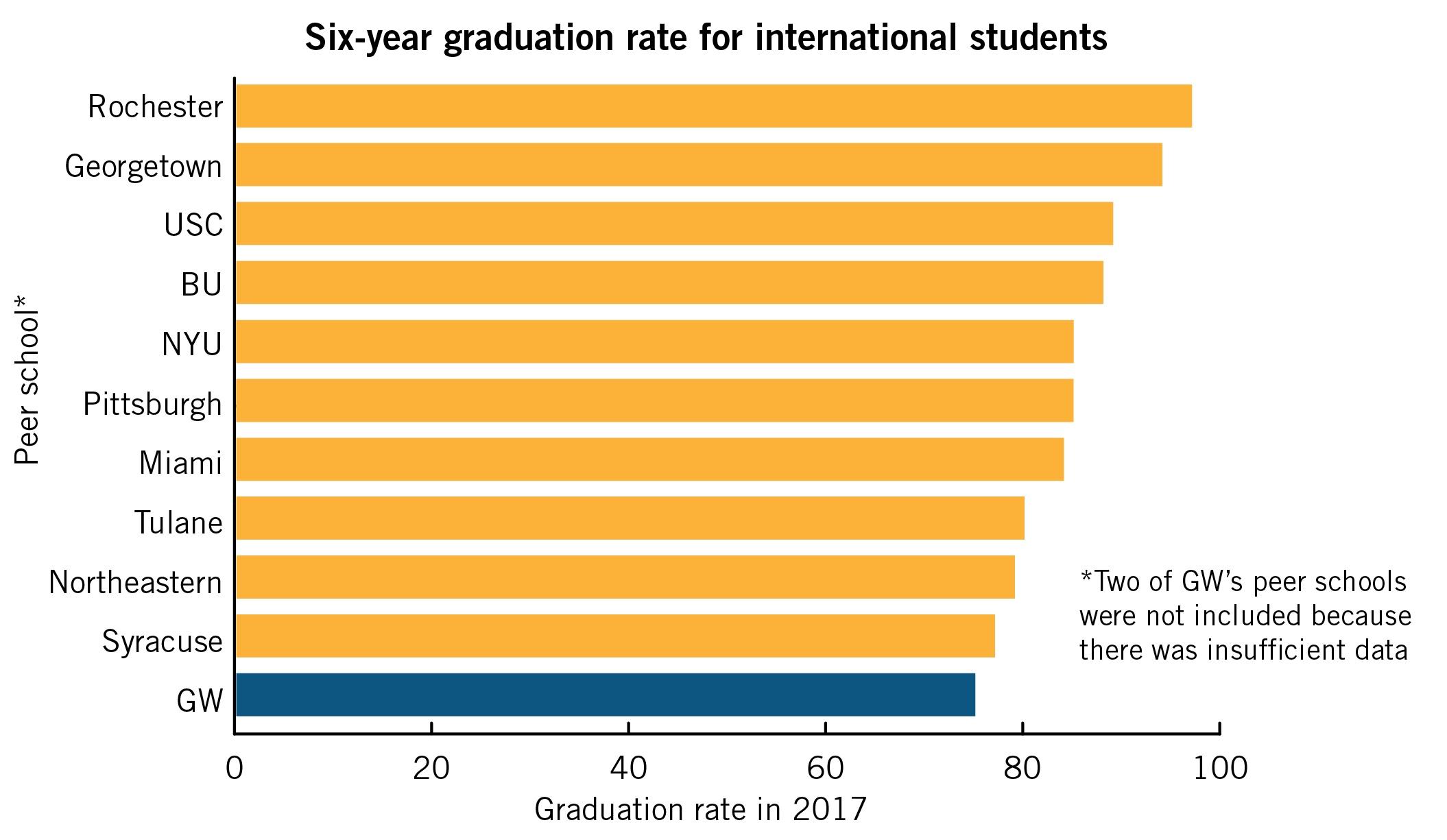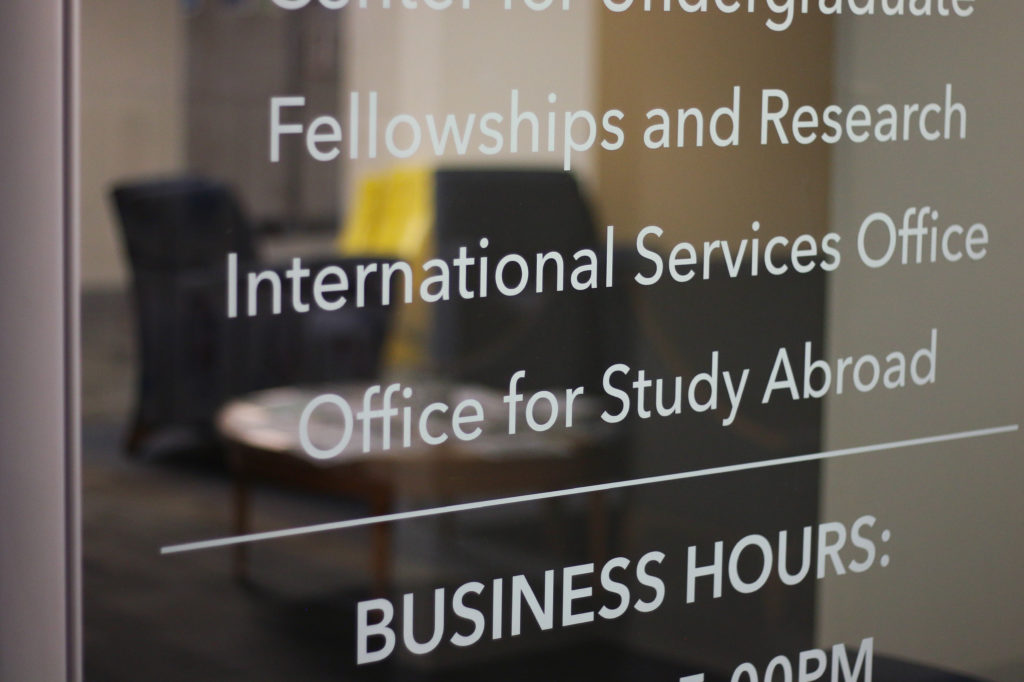Updated: Oct. 1, 2018 at 10:18 p.m.
The University graduates international students at a lesser rate than nearly all of its peer institutions.
GW’s six-year graduation rate for international students stood at 75 percent last academic year, about 10 percent lower than at least 10 of its 12 peer institutions, according to data from U.S. News & World Report. Higher education experts said the relatively low rate could be attributed to a lacking sense of community among international students, leading them to feel isolated among domestic students.
Of the University’s peer schools, the University of Rochester and Georgetown University have the highest six-year graduation rates for international students at 97 and 94 percent, respectively. Boston University, New York University, the University of Pittsburgh and the University of Miami have six-year graduation rates for international students hovering at about 80 percent.
The University enrolled about 1,200 international undergraduate students last academic year, accounting for about 10 percent of the overall undergraduate population, according to institutional data.
Upping the graduation rate
Laurie Koehler, the senior vice provost of enrollment and the student experience, said international students may not stay for six years for the same reasons that domestic students may leave – financial, medical, personal or academic barriers.
“GW clearly performs quite well, but we believe strongly that we can do better,” Koehler said in an email.
Over the past three years, she said the six-year graduation rate for international students has swung – rising to 84 percent in fall 2010, the same as the overall six-year graduation rate. That rate fell to 76 percent for the 2009 cohort – 7 percent lower than the six-year graduation rate for all undergraduates from that year.

Emily Recko | Graphics Editor
Source: US News Data
The “swings” in percentages over the past three years aren’t surprising, given the relatively small number of international students, she said.
Koehler declined to say why GW’s six-year graduation rate is the lowest among its peer schools. But she said the University’s percentage is 15 percent higher than the national six-year graduation rate for international students, which stands at 60 percent, according to the National Center for Education Statistics.
To improve the University’s overall graduation rate, she said that officials have been “taking a number of concrete actions” to remove academic, administrative or financial barriers that could prevent students from graduating. She did not specify what actions officials are taking to address these barriers.
Koehler said that with a rising number of undergraduate and graduate international students, officials have upped the number of resources available for international students to “ensure a stronger sense of community and support,” but did not specify what the resources include.
‘Overlooked’ on a large campus
Krishna Bista, an associate professor at Morgan State University in Baltimore who has written several publications about international students in higher education, said the international student community could be overlooked because officials are trying to accommodate an array of students from different racial and geographical backgrounds.
Officials and students leaders launched programs like an airport welcome and a mentorship initiative in the spring in an effort to make international students feel more welcome upon arriving on campus. A self-study of GW’s international outreach last October also revealed that the University lacks geographic diversity for international students, bringing in students mainly from countries like India and China.
“If you look at the proportion of the international students and the existing services in a big campus – there are often not enough,” Bista said.
Daniel Klasik, an assistant professor of higher education administration, said international students might not graduate because they don’t feel like they “fit” on campus, which could be the product of a cultural disconnect or financial troubles that domestic students may not encounter.
International students typically pay full tuition, funneling money into an operational budget that is nearly 75 percent tuition-reliant.
“This means that international students have to either rely heavily on aid from GW or other outside sources that may be unreliable or have to fund themselves,” he said.
Increasing outreach
Higher education experts said recently launched initiatives could help students feel more welcome from their first day at the University, but officials can also up GW’s international student graduation rate with academic programs, like specialized advising or speech services that last throughout their entire time at school.
Donald Heller, the provost and vice president of academic affairs at the University of San Francisco, said the University’s newly launched mentorship and airport welcome programs could gradually increase its graduation rate because international students are immersed in the community upon starting at GW.
The University also added a new scholarship earlier this month for international students, where, starting next academic year, two international students will be granted annual, renewable scholarships that cover at least 50 percent of tuition.
“If well-designed and implemented, programs like this should help improve the graduation rates of international students, particularly if they’re lagging behind other groups,” Heller said in an email.
Bryant Priester, the director of international students and recruitment at Purdue University, said that in addition to services offered to international students when they arrive on campus, Purdue designates staffers in several departments, like academic advising and the health center, to specialize their services for international students.
Priester added that officials need to tune into the needs of international students to understand how to address a relatively low graduation rate. Officials could conduct interviews with international students who have left school to determine the exact reason a particular group of students is not graduating at a higher rate than domestic students, he said.
“It does take listening to the needs of students and understanding this is something that someone will need in order to be successful on a particular campus,” Priester said. “I know that at least in my experience at Purdue, this has allowed for our success.”
Shannon Mallard contributed reporting.
This post was updated to reflect the following clarification:
A previous version of this post used the words “retained” and “retention” to refer to international students graduating within six years. Some language was updated to clarify that the article discusses six-year graduation rates, not retention rates.





